-
Posts
164 -
Joined
-
Last visited
Content Type
Profiles
Forums
Store
Help Articles
Posts posted by MikeTMD
-
-
There are quite a few points that I would like to cover with regards to internal (core) temps and degrees of beef doneness , however for right now may I suggest a link with pictures from Certified Angus Beef ®
Few quick notes:
I'm with e-monster. I typically do medium-rare beef sous vide to around 54C, and that's how it comes out: bang-on medium rare.... I find that in order to get anything cooked SV which resembles rare steak cooked conventionally I cannot exceed a core temperature of 48C/49C. At 54C any beef I've cooked is what I would call medium - i.e. uniformly pink throughout with no red/raw appearance at all. Cooking at any temp higher than 54C the beef starts to lose it's pinkness and becomes increasingly grey as the temperature is increased. For me any "greyness" at all starts to get into what I describe as well done.
Cheers,
Peter.
This is critical:
Whether we apply conventional cooking technique, or cook our steaks SV the goal is to achieve right internal (core) temperature for a desired degree of doneness. Needless to say, SV allows to achieve much more precise internal temperature, as well as allows to do it with ease.
However,
temperature points of doneness are identical for proteins cooked conventionally, and for the same proteins cooked SV.
I would also like to ask any of you to support your statements about degrees of beef doneness with appropriate pictures, please.
-
Mike, normally I would think that 15 minutes isn't enough to bring prime rib or rib-eye to medium rare, but I guess that depends on the starting temperature.
Why do you use 61C, instead of something like 55.5C?
How did you sear it afterwards (or before)?
Robert, 15 minutes would most certainly be not enough time for a large cut like whole prime rib, and I would have give it another 5-10 minutes for a rib-eye steak. However, cap of the rib-eye is a relatively thin muscle, so I cook it just like I would cook tenderloin, as far as time/temp are concerned.
I have to ask you for clarification of what you mean by "starting temperature" - I start and finish SV at precisely the same temperature, depending on how I want my protein cooked ( generally speaking: 54-56C for fish, 61-64C for steaks)
There is no benefit of having a cooking bag in the bath as it being warmed up, if that's what you are asking.
61C is internal temperature for any steak done rare, 62-63C - medium rare, 64C - medium. 55.5C would be undercooked by any standards.
Typically, I flash sear my steaks in very hot clarified butter ( 5-10 sec. on each side) after poaching, immediately prior to serving.
-
[Moderator note: The original Sous Vide: Recipes, Techniques & Equipment topic became too large for our servers to handle efficiently, so we've divided it up; the preceding part of this discussion is here: Sous Vide: Recipes, Techniques & Equipment (Part 5)]
This weekend I've cooked with two somewhat non-traditional cuts of meat:
Lamb Tenderloin:
- Slow Baked Beets, Compressed Aian Pear and Microgreens, Red Wine Jus ("Sauce au Poivre")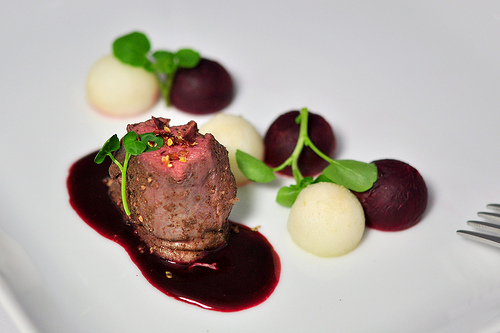
The tenderloin was sous-vide with kubbeh spices @ 63C, for about 20 minutes
Cap of the Ribeye: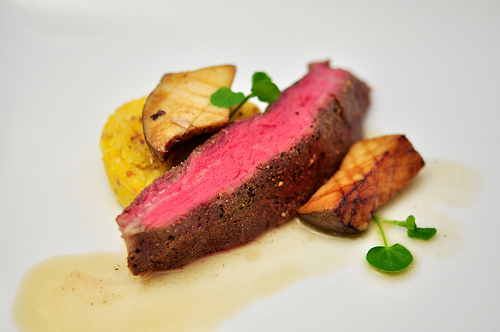
This is a pretty straight-forward dish - cap of a prime rib ( "lifter meat") sous-vide to rare with simple seasoning, 61C for about 15 minutes
Both cuts truly shine when SV technique is applied. -
About the only thing I'm sure of is that there is more work to be done before we fully understand this interesting cooking technique.
Peter,
More in agreement with you I can not be - there is a lot work/research to be done.
Personally, I rely on empiric evidence ( and trial and error, as its integral part) rather than theoretical projections by even the greatest minds out there.
In conclusion, I would like to show you a picture of short ribs cooked SV:
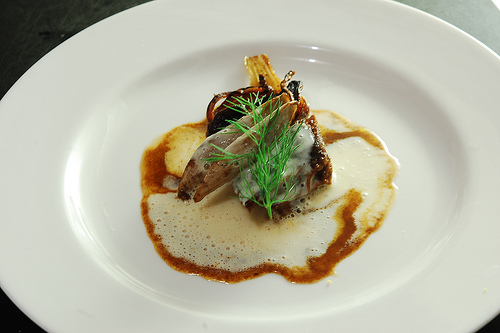
Short Ribs were cooked at 88C for 6 hours - wonderful texture. ( this plate was inspired by Alinea recipe)
-
Mike,
So, I guess not all flat-iron steak is tough.
Thanks, e_monster,
That is the point that I am trying to make. We have people form different countries (and different kitchens), so sometimes definitions get blurred.
I like this source:
It's an expensive book, but one can "Look Inside!" on amazon.com.
Just for reference: Flat Iron is described on p. 18, cut number 114D.
-
I took a liberty to compare cooking times for Lamb Loin, as per several different sources:
Achatz: 20 minutes @ 57C / Core temp - not specified
Keller*: 35 minutes @ 60.5C / Core temp - not specified
Roca: 20 minutes @ 65C / Core temp - 60C
Stampfer: 25-30 minutes @ 66C / Core temp - 64C
(* - Keller suggests the time and temps for lamb saddle - loin and tenderloin connected by transglutaminase)
I chose Lamb Loin for this illustration primarily because all four authors described cooking that particular cut SV.
Should anyone be interested, I would be happy to illustrate suggested temps for tenderloin, and/or braised cuts.
I would like to point out that the sources quoted come from four different, professional and accomplished chefs, as such their recommendations, in my opinion should not be ignored.
-
Mike, that's fair enough.
Tonight we had some Tip-Tip (Morton's Chardonnay marinated) that was cooked for 12 hours. Whereas my previous trials with 1.5 and 2.5 hours at 131F showed that the meat was still tough, 12 hours was perhaps too much -- the meat was almost falling-apart tender (perhaps because of the marinade), although my wife loved it.
If in fact 24 hours for flat-iron is too much, I will certainly report that fact.
As to the micro-biology aspects, I will wait for your references.
Bob
OK, I am back home, so please find the reference:
Sous-Vide: Garen Im Vakuum
Viktor Stampfer
2009 Matthaes Verlag GmbH, Stuttgart
ISBN-10: 3875150279
ISBN-13: 978-3875150278
"The correct temperature for cooking sous-vide"
Chapter by Bruno Goussault pp.14-15
Noteworthy, the author cites microbiological studies performed at CREA.
-
The point of cooking a steak-type cut SV, in my opinion is to achieve perfectly uniform temperature ( i.e. degree of doneness) throughout the protein, and, as a consequence to avoid overcooking. Why cook a steak for 24 hours , when all one needs is 20-30 minutes of SV cooking in a medium (water) just a few degrees warmer? "Steak" cuts do not have a lot of collagen we need dissolved, unlike short ribs or shanks, nor there is abundant fat to be rendered out.
.... Tri-tip, flat-iron steak and chuck are cuts that are flavorful but not tender.
If you cook chuck to medium-rare as you would a ribeye, you will have a tired jaw by the time you finish eating. Despite having the word 'steak' in its name, chuck "steak" is a tough cut that in my opinion benefits from the tenderizing effects of temperature over extended periods of time. The amount of tenderizing depends on how tough the cut it. Flat-iron steak cooked for 24 hours (per Doug Baldwin's suggestion) has to my taste a really nice texture that it doesn't have when it is pan fried as one might cook a more tender cut like filet or ribeye.
.....
It's hard to argue personal taste matters - flat-iron steaks to me do not need additional tenderizing, but it's clearly a matter of individual preference.
-
Mike, I do appreciate your suggestions/advice.
However, right now, I am torn between someone (eMonster) who has apparently tried this technique, vs. your concerns, which apparently have not been tested, due, perhaps understandably, to your concerns.
My personal observations to date are that cuts like chuck (which OUGHT to include flat-iron, since it is part of the same general section of meat), are relatively tough cuts of meat that require extended time to dissolve the collagen. Now, I may be completely wrong in this regard, and if so, I will certainly report that fact. If I ruin a single steak -- oh well, so be it.
Now, I can't agree that 61- 63C is medium rare, at least to my taste. It is medium, or worse. I think that 55C is medium rare, and 51C is verging on rare, and delicious. So there is no way that I am going to cook something to 61-63C (except maybe pork, because my wife doesn't like "pink".)
Now, as to the question of whether 24 hours at 55C is safe or not, I have seen the sometimes contentious exchanges between you and others on this list. Frankly, with all due respect to Thomas Keller, he is admittedly a great chef, and we certainly owe a lot to him, but it is not a microbiologist, and I doubt that he could compute a D60 reduction if his life depended on it. I hope I'm not insulting him.
Nathan Myvold and Douglas Baldwin, on the other hand, have a strong mathematical background, and CAN in fact interpret the existing scientific reports and even the FDA recommendations, and to date, I trust their time-temperature charts and statistics.
I am not disputing your credentials as a physician, but I don't know your speciality or your particular expertise in this field. I don't mean to insult you, but you could be a podiatrist, or a orthopedic surgeon, or a psychiatrist or speech pathologist, and in which case you might not know very much more about microbiology than I learned as a physicist and a former EMT.
For that reason, it if you can cite specific scientific reports to support your contention, I will be happy to try to independently evaluate them. At the moment, I am not inclined to accept your contention at face value.
Now, if I show up dead the day after tomorrow after eating the 24-hour flat-iron steak, my descendants will no doubt apologize to you on my behalf! :-)
Dear Robert,
First and foremost - I hope we never have to deal with the latter scenario.
Secondly, microbiology is an integral ( and lengthy) part of MedSchool curriculum, and as such, I hope, deserves at least some of your respect.
I am away form home right now, but I will make the sources and studies available to you very shortly.
That said - are we trying to share SV cooking experience and tips, and make our food taste better? As such, and I base that statement on daily SV cooking experience: there is no advantage to cooking a steak for 24 hours - it's simply unnecessary, for the reasons I described above. However, if you come across a published recipe by a professional Chef in the course of your independent evaluation - please post it, it would be interesting to try it.
-
I am confused as to your advice here - specifically the food safety aspect.
In Douglas Baldwin's excellent article:
Douglas Baldwin - A Practical Guide to Sous Vide Cooking
He recommends cooking Flat Iron steak at 131F (55C) for 24 hours.
Both he and Nathan have stated many times that the requirement to cook meat at >60C is a myth and that the pathogens which could harm us are either neutralised or sufficiently reduced to no longer be a threat when the meat is cooked for an extended period.
If I understand it correctly - cooking meat at "dangerously low" temperatures is OK for up to 4 hours, but when going over 4 hours it needs to be by a wide margin (eg 24 hours). My further understanding is that this is OK for immediate consumption but extra precautions need to be taken for SV & Hold use.
I have some beef short ribs in the tank at 56C at the moment and by dinner time tonight they will have been in there for 48 hours.
Are you suggesting I am doing something dangerous?
Is all of the low temp / long time advice on this forum incorrect?
I need to know before I feed the family tonight.
Maybe Nathan or Douglas could comment.
Regards,
Peter.
Dear Peter,
Thank you for your reply.
For the record, I truly respect the work and research by both nathanm and Douglas Baldwin.
Also, I wouldn't go as far as as universally rejecting all low temp/long time advice - there are certain applications that from my standpoint are perfectly acceptable.
That said, my approach to SV is primarily utilitarian - I routinely ( in fact - daily) apply SV in my cooking, mostly for proteins and use it because of the qulity, texture and most important - taste of final product. Also, I have enormous respect for Chef Keller, and would take his kitchen-tested and well proven instructions over even the most accurate hypothetical calculations.
The point of cooking a steak-type cut SV, in my opinion is to achieve perfectly uniform temperature ( i.e. degree of doneness) throughout the protein, and, as a consequence to avoid overcooking. Why cook a steak for 24 hours , when all one needs is 20-30 minutes of SV cooking in a medium (water) just a few degrees warmer? "Steak" cuts do not have a lot of collagen we need dissolved, unlike short ribs or shanks, nor there is abundant fat to be rendered out.
You mentioned you are planning to cook for your family - personally, I would do for my family ( esp. if there are children involved) exactly what Chef Keller does for his guests, and avoid a risk of anaerobic contamination ( to which, again, children are more susceptible) altogether.
There are many participants in this thread, and there are many opinions - all of which deserve respect. My suggestions to you are based on first-hand SV experience and common industry standards, but whether to accept those is your individual choice, of course.
-
My intention at the moment is to cut the flat iron steaks about 1-1/2" thick, add some dry-rub spice (probably mesquite, or Montreal steak), Jaccard them, and seal them in FoodSaver bags. Then, as required, I would cook them for 24 hours at 131F, per eMonster's suggestion, and sear them again, unless someone has some better recommendations.
Any other ideas or recommendations?
Bob
Dear Robert ,
If I may - I would strongly discourage you from cooking flat-iron steak the way you have described, and for several reasons.
First, flat-iron is a steak cut, and as such it simply does not need that long of a cooking time, just like fillet mingnon does not need to be braised in conventional cooking;
Secondly, you are about to put a piece of protein in a vacuum bag at 55C/131F, and bathe it for 24 hours, essentially creating a perfect medium for harmful anaerobic bacteria ( Thomas Keller in "Under Pressure" specifies that any protein held at temps below 60C for longer than 4 hours is to be discarded, as it is presumed contaminated - more in agreement I can not be, both as a physician, and as a cook).
My suggestion is to cook flat-iron steaks at desired temp/doneness ( my preference is medium rare @61-63C), for about 20-45 minutes, depending on the thickness, and flash brown the steaks in clarified butter, just prior to service.
-
Anyone have a fabulous sous vide technique (time and temp please!) for
making Bernaise sauce?
It's always a pain to be making a meal for guests, and trying to make a
perfect Bernaise at the last minute....
anyone done it?
or even just making the sauce the standard manner, substituting a water bath for the bain marie....if so what temperature for the watre bath?
Dear Dr.,
The Vanilla Mousseline this recipe is essentially Bearnaise with vanilla - I would be happy to give you a recipe and detailed technique, if you are interested.
Personally, I do not see a compelling reason to use sous-vide in Hollandaise-based sauce preparation, or to even hold the said sauces, however, in Creme Anglaise recipe /"Under Pressure" (p.252) Thomas Keller recommends dropping a bag with whipped yolks in 85C bath, reducing temp to 82C and cooking it for 20 minutes.
If I may make a suggestion: adding a touch of xanthan gum would considerably extend holding time of any Hollandaise-based sauce in either home or a restaurant kitchen.
-
One of my absolute SV favorites is shellfish. Recently, I have made two dishes utilizing squid and lobster.
Salad of Squid and Hearts of Palm - Atlantic Squid, Fresh Hawaiian Hearts of Palm, Asian Pear, Squid Ink Sauce, Pepper Confetti, Mizuna Garnish.
This one is straight from "Under Pressure":
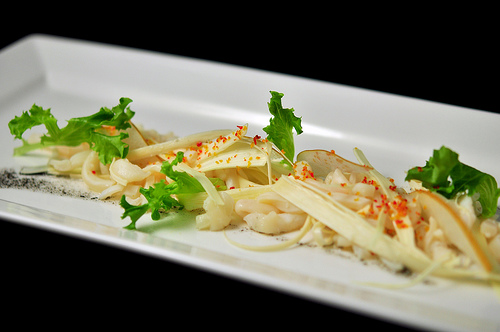
I have reservations about saying that this dish is inspired by Thomas Keller, rather it's [almost] exact replica of a plate described and pictured in the "Under Pressure" Fish and Shellfish chapter. However, I added a few touches of my own, and replaced suggested nectarines with Asian Pears.
Squid was cleaned, sliced in ribbons, and cooked sous-vide @65C for 10 hours with thyme, rosemary, coriander, cumin, alspice, ginger and chilies. Original recipe does not suggest alspice and ginger, but I felt it'd be a nice addition.
Fresh hearts of Palm were sliced on a mandoline, pepper confetti was made from sweet baby red, orange and yellow peppers, squid ink sauce made with fresh squid ink, canola oil, mustard an yuzu - the latter being added instead of lemon oil Chef Keller used in his original recipe.
This is a very fresh, refreshing plate, albeit and perhaps not quite as refined as one would expect from Chef Keller, but it takes advantage of extremely fresh and unique ingredients, and capitalizes on the use of sous-vide texture of squid.
The second plate was a bit more of a free-style approach:
"Lobster and Squash, Vanilla Mousseline" - I got the idea during my lunch at "Per Se"
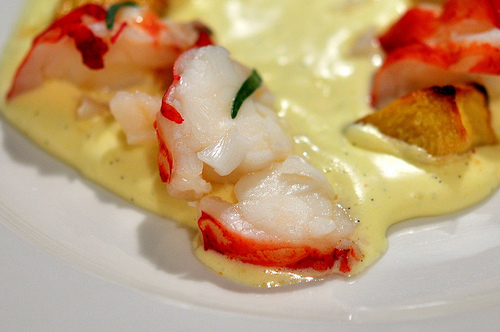
Overall, it worked - I especially enjoyed making the "vanilla mousseline". Unfortunately, I was not able to find any red-fleshed squash - which basically ruined the dish for me. Lobster was cooked sous-vide at 59.5C with sweet cream butter, tarragon and spices - quite good.
Please see additional pictures on flickr
-
Mike what type of duck was this? I am assuming it must have been a Pekin since I find I have to cook a magret or a muscovy breast for 4 hours to get them tender.
Ruth,
It was Maple Leaf FarmsPeking Duck breast with skin on and it was not falling apart tender, but rather had a nice bite to it.
-
I wanted to experiment a little bit with smoking/SV combination.
"Smoked Duck Breast, Asian Pickles, Tomato Pearls and Hawaiian Black Salt".
I smoked duck breast over oak saw dust for just a few minutes, brushed it with marinade made with light and dark soy sauces, Xaioxing wine, Five Spice powder and a touch of Kafir lime leaves ( similar marinade sans kaffir lime, is usually used in a Chinese dish called "Smoked Fish", although fish is not smoked at all, but rather gets said flavor from five spice mixture).
I will absolutely use this approach to smoking form now on - oak has very nice flavor, just a touch of it goes a long way, and five-spice accentuates the flavor and adds a pleasant, but not overpowering aroma.
The duck breast was then poached Sous-Vide at 61C for about 45 minutes. This is the final product before plating:
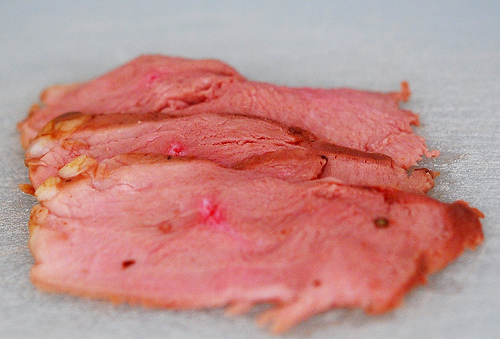
Meat was then served with home-made Asian pickles ( carrot, turnip, shitake mushrooms, pickled in rice vinegar with Rock sugar, ginger, Sichuan peppercorns and smoked chilies - I wanted to enhance smoked flavor, without using a lot of actual smoke). Also, I added a touch of pickled eggplant , but kept in on the side - someone in my dinner party is allergic to aubergines.
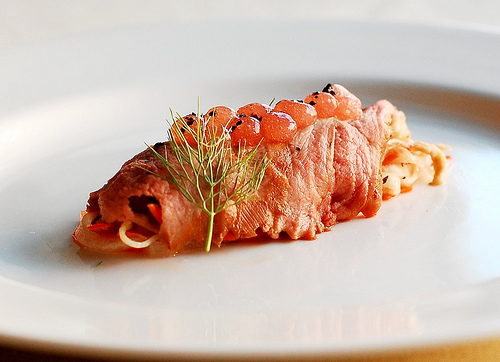
Plain tomatoes would be a little boring, so I made Beefsteak Tomato Pearls for garnish, and added a touch of black salt for color contrast.
This dish would pair very well with sake, but today I opted for Belgian Kriek Cherry Beer , which worked really well.
Overall, this was an outstanding plate - great flavors, texture and secondary flavors. Will do again in a hearbeat!
See the entire set on Flickr
-
... Glaze - I rarely do glaze so I could use help here...
Glaze should be no problem:
if you are doing chocolate glaze: chocolate + heavy cream+glucose/light corn syrup;
if you decide to do anything else: anything else + ClearJel ( modified corn starch, is really what it is);
ClearJel is cheap, and easily available from many sources (I get mine @http://www.sweetc.com/), it gives you stable and completely transparent glaze, which is why many pastry chefs favor it.
Good Luck!
-
Mike that's a very high temperature, would you do it again?
Can I hassle nathanM or does anyone know the progress of that book of his?
I would - the result was quite enjoyable.
That said, the entire dish was ... I DK... boring.
-
OK, here are the remaining steps of
"Skate Wings with Saffron Jelly":
adopted from
Viktor Stampfer
Sous-vide
Cooking in Vacuum
© 2009 Matthaes Verlag GmbH, Stutgart
ISBN 978-3-87515-027-8
Skate was rolled and S-V @ 54C for 30 minutes (original recipe recommends 56C for 25 min, to the internal temp of 54C, but as I said earlier, I see no reason not to cook at the final temp - the time difference would be negligible), chilled and kept cold for several hours, so the natural gelatin can set:
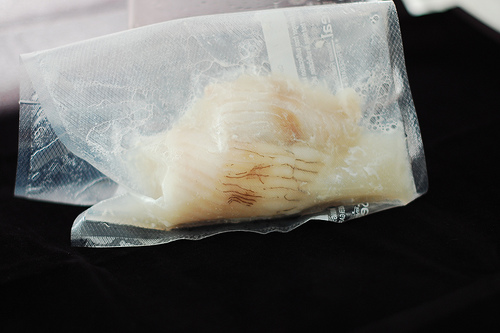
Close-up: look at the gelatin in the bag:
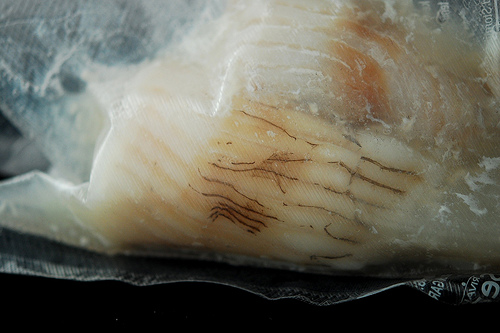
The final product was extremely tender. Notice: there is no air in the fish roll at all, it's homogenous because of the "bloomed" gelatin:

Meanwhile, some tomatoes were baked for plate presentation:

Some were dehydrated for garnish:
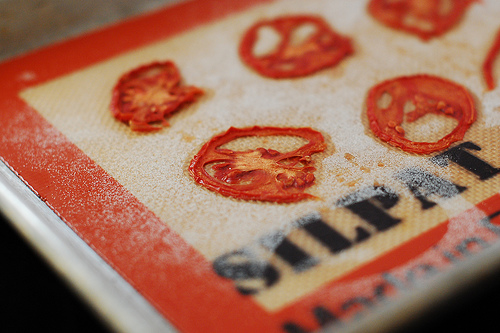
Final plate assembly:

Please look at the entire set of pictures on flickr
-
Mike, is there any air taken out of the jar? (You can seal jars like this in a chamber vacuum machine, I know.) If not, it's not strictly speaking "sous vide" so much as "very precisely temperature controlled." What were the supposed benefits?
Yes, the air was taken out of the jar - I am puzzled about the benefits of that technique, though. Chef Stampfer did not give any explanation or reason why they employ this technique, although the recipe is quite detailed as far as how to cook this particular dish.
I'll post the remaining steps and photos shortly.
-
This is somewhat new to my S-V playbook: cooking in vacuum jars.

The original recipe calls this Saffron Jelly, although the texture would be closer to mousse/ gefilte fish, as far as I am concerned.
Forcemeat was placed in a sterilized jar, topped with fish stock, and cooked S-V at 98C for 2 hours.
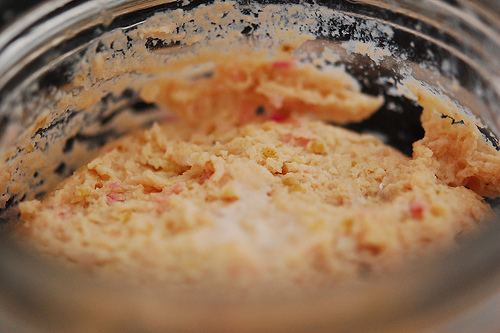
The final product is quite smooth, almost pate-like. That said, I am not certain if there is any advantages to taste or texture due purely to S-V approach.
-
"Slanted Door" is quite innovative, similar to "Momofuku/Ssam". Still, I am curious what selection criteria they've applied to their list.
-
Has anybody ever heard of Taiwanese Soy Sauce, a.k.a. "Soy Cream" or "Bottom of the
Barrel Oil" - essentially, Chinese equivalent of Balsamic?
If so - who makes it? How much does it cost? How do you spell it in Cantonese?
Is it available in US or Europe?
-
Has anybody ever heard of Taiwanese Soy Sauce, a.k.a. "Soy Cream" or "Bottom of the Barrel Oil'? If so - who makes it? How much does it cost? How do you spell it in Cantonese?
-
Mike, how does it compare to the other two book?
Worth the money?
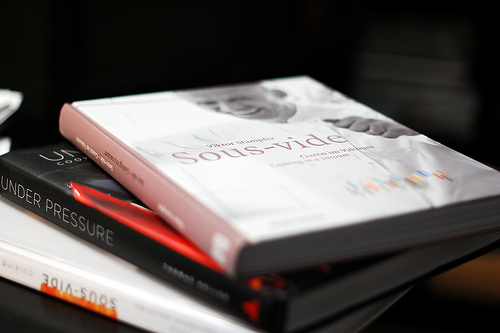
I don't know.... It's a good book, but I find a few points to be very questionable ( e.g. - the author suggest cooking all fish @56C to the internal temp of 54C - first, why not cook at 54C? second, salmon @54 is overcooked/monkfish @54 may even be undercooked). Some of the recipes, esp. the ones involving cooking in jars are closer to "preserving/canning" than "sous-vide", but it's still an interesting approach.
Finally, there is the cost - $125 is a lot for a book of that caliber, I think. Again, there is a lot of good info, though...



Sous Vide: Recipes, Techniques & Equipment (Part 6)
in Cooking
Posted · Edited by MikeTMD (log)
Just another SV exercise - flank steak/ Atlantic halibut.
I got an inspiration from a dish by Chef Gustav Ottenberg form Leijontornet restaurant restaurant in Stockholm, Sweden ( described and pictured on pp. 280-281 in the new COCO book):
Flank Steak, Pickled Pearl Onions, Onion Puree, Grean Beans, Yellow Mustard Seed
Flank steak was season with kosher salt, black pepper and kebbeh spices, vacuum-packed and cooked to medium-rare at 64C for about 2 hours ( for presentation purposes I decided to cook the entire steak and slice it just prior to service).
Also, same dinner - different dish:
Atlantic halibut poached in extra virgin olive oil, Prince Edward Island mussels, Brussel sprouts, Chinese broccoli and Black Garlic sauce, microgreens:
This dish is inspired by similar plate at Gramercy Tavern in NYC.
Halibut was poached in a vacuum bag with EVOO, fenugreek and saffron @ 59C for about 15 minutes (tecture was fall-apart tender, but not at all mushy), mussels were steamed with herbs, Brussel sprouts were caramelized with butter, Chinese Brocolli puree was thickened with light brown roux.
I absolutely love the 57-59C range for white fish - great and consistent results.
Just for comparison - please look at the original dish:
I would be happy to answer questions, if any.